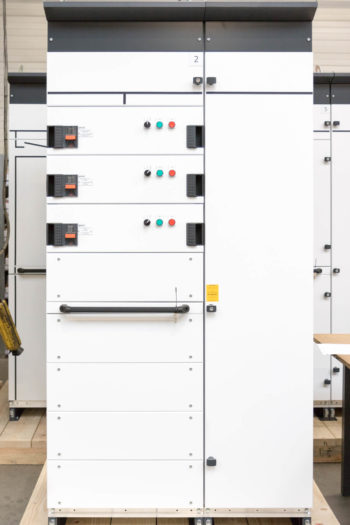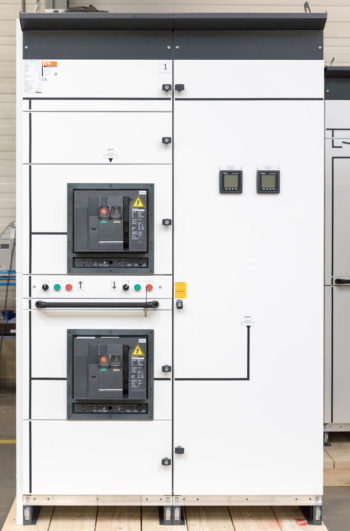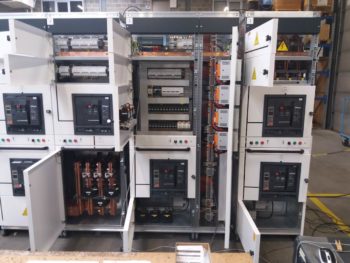Do you have a question?
If it is about control panels, we have the answer.
Low-voltage boards at offshore sub-station
A truly incredible sight. We had a first-row seat to the launching and shipping of an offshore sub-station. Destination: the Hohe See wind farm in the German North Sea, around 90 km north off the island of Borkum. On board: three transformers, three current compensation coils… and our low-voltage boards.
The Hohe See offshore wind farm has 71 turbines, each with a capacity of 7 MW. This is good for two billion kWh of renewable electricity, enough to supply 560,000 households with power. Hohe See extends over an area of forty square kilometers, the same size as the Municipality of Ranst. Or, if you are more familiar the other side of Belgium, comparable to the surface area of Merelbeke.
LOW-VOLTAGE BOARDS FOR OFFSHORE
The sub-station is the electric heart of the offshore turbine park. In the Hohe See, it is a heart that is 55 m long, 30 m high and weighs 4,000 tons. All the electricity produced merges in that transformation station and is sent to the mainland through an underground pipeline.
“Of course, such a station also needs power,” says Project Manager Chris Rasschaert. “That’s where we came in. As a sub-contractor to Engie, we designed and assembled the low-voltage boards. The main low-voltage boards contained integrated programmable logic controllers for safety circuits and a visualization of the fault and position contacts of all safety devices, plus the power measurement, including full interlock and intertrip locking with hardwired relay and coils. The distribution boards have integrated modules for reporting and a visualization of the fault and position contacts of all safety devices. These also required power measurement.”
MEASURABLE AND ADJUSTABLE FROM A DISTANCE
“This involved a total of six large Okken main distributors from Schneider Electric. The naval version, of course. And another nine Prisma PH version sub-distributors. All these panels are equipped to be monitored and operated remotely, so it’s not necessary to be on location. You can follow and intervene from the mainland using your laptop.”
“Our low-voltage boards are the heart of the electrical installation. They are responsible for an important percentage of control between the generators, for the grid follow-up and the link with the turbines. The engineering was quite a challenge. There were many different standards and specifications to combine. There were also technical challenges. The panels were extremely complex, with a great deal of intermediate wiring, for example.”
“There was also the factor of compactness. Everything has to be as small as possible for the offshore sector. For example, normally there is ample room for the control to be on a separate panel. But we were required to incorporate the PLCs into the panels themselves. No easy task. It meant we had to let go of Okken’s standard structure in order to engineer a solution ourselves.”
“And then there are the constant adjustments. The big lines of the sub-station were already in place. But as often happens during a construction project, the engineering details are available only gradually. As a result, things often change when it comes to the low-voltage boards. And it was up to us to respond quickly to those changes.”
LOW-VOLTAGE BOARDS OF THE HIGHEST LEVEL
“In the field of panel construction, this work was of the highest level. I have been in the business for quite a few years and these were the most challenging panels for me and my team. The compliments from the factory acceptance tests were nice to hear.”
“In addition, the administrative work was also a lot more intensive, from the right certificates to the O&M manuals and maintenance documents, even the documentation for our own guys who connected everything on location. The low-voltage boards were not put on the platform as a whole; we had to disassemble the cells and then rebuild them. This means we had to document and prepare everything properly, so that efficient and high-quality work could be delivered in the field.”
“That connection in the field was the task of my team,” says Stijn Cuppens. “In this case, in Hoboken, where the sub-station was built in a workshop. The connections were made in different phases, spread over a period of around two months. The harbor acceptance tests were followed by adjustments. It’s all a matter of flexibility. When we were at work, the power needed to be off, of course. Which meant that the rest could not continue. As a result, we mainly worked during the quiet hours, like at night.”
GWO-CERTIFIED
And then it was all over on May 29. The sub-station left Hoboken for its final destination in the German North Sea to be connected to the planned jacket foundation using a crane vessel with a capacity of 14,000 tons.
“It is certainly not a final farewell to our low-voltage boards. There may still be extensions or adjustments. But, this time, it will not be in the comfort of a workshop, but on the high seas,” concludes Stijn. “That’s work for our GWO-certified service technicians!”



